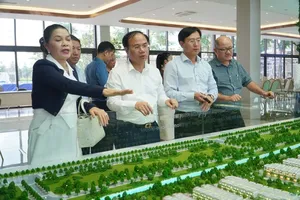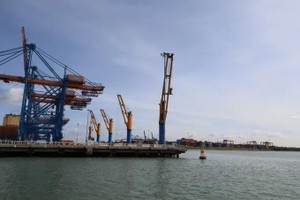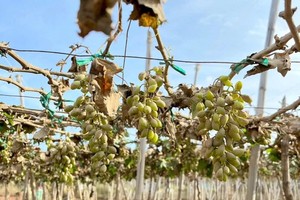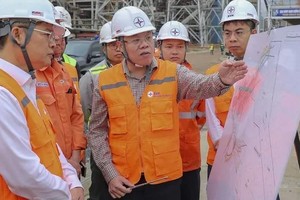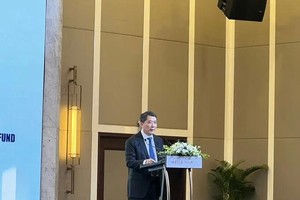The merger of Binh Duong, Ba Ria - Vung Tau, and Ho Chi Minh City is considered a strategic move to form a high-tech megacity — a hub converging three strategic pillars including finance and high technology, modern industrial manufacturing, and seaport logistics. This is not just a matter of redrawing administrative boundaries but a redefinition of the Southern region's economic role in the global value chain.
Establishing a competitive growth pole
Recently, during the signing ceremony between the People's Committee of Ho Chi Minh City and US-based AMD Corporation, several leaders of departments and agencies emphasized the importance of expanding urban development space. Deputy Prime Minister Tran Hong Ha stated that reorganizing development space by regions is an irreversible trend.
Deputy Prime Minister Tran Hong Ha announced Vietnam is moving away from a diffused development strategy across all 63 provinces and cities. Instead, the focus will be on 34 dynamic regions, aiming to concentrate resources and foster growth poles large and competitive enough to rival others in the region.
He emphasized that the high-tech megacity model that Ho Chi Minh City is aiming for could become the first testing ground for regional development thinking.
A highlight of the merger proposal is the clear and strategic division of roles among the three localities. Ho Chi Minh City will serve as the center for finance, high technology, and innovation, focusing on research and development (R&D), high-quality education, and the digital economy. Meanwhile Binh Duong Province will take on the role of modern industrial manufacturing center, leveraging its dozens of large industrial zones, transparent investment environment, and strong capacity to attract FDI. Ba Ria - Vung Tau Province will develop into a center for logistics, seaports, and energy, capitalizing on its deep-water ports and strategic geographic location.
Commenting on this issue, Dr. Can Van Luc, member of the National Financial and Monetary Policy Advisory Council, said that reorganizing development space with functional division among Ho Chi Minh City, Binh Duong, and Ba Ria - Vung Tau is a sound move.
He suggested that Ho Chi Minh City should prioritize the retention of high value-added sectors, including finance, technology, cross-border e-commerce, and innovation. These sectors demand minimal land while producing significant added value and robust spillover effects. Conversely, traditional manufacturing, processing, labor-intensive industries, and those requiring substantial infrastructure can be gradually moved to Binh Duong Province to alleviate the infrastructure burden on the central areas of HCMC.
It is also worth noting that Binh Duong Province is currently a national leader in FDI attraction, with over 4,400 projects and more than US$42 billion in registered capital. It boasts one of the most advanced industrial infrastructure systems in the country, ready to receive investment waves shifting from developed countries, especially as investors increasingly favor "smart manufacturing" models.
General Director of Viet Thang Jeans Company Pham Van Viet said that expanding and specializing industrial parks not only helps businesses increase their localization rate but also helps Vietnam participate more deeply in the global value chain, meeting strict standards from the US and European Union (EU) markets.
The biggest strength of Ba Ria - Vung Tau Province lies in the Cai Mep - Thi Vai deep-water port cluster, which is currently capable of receiving container ships of up to 214,000 tons and connecting directly with European and North American markets.
According to Deputy Head Le Viet Phuc of the Management Board of Ba Ria - Vung Tau Industrial Parks, in just the first half of 2025, the province attracted over $1.57 billion in investment capital, and the industrial land occupancy rate reached nearly 70 percent. This locality is also moving towards an ecological industrial park development model, integrating renewable energy and digital technology, ready to serve as the main import-export transshipment station for the Southern key economic region.

Regional value chain from production to export
One of the significant advantages of the integrated super urban model is the inter-regional logistics capability. Experts believe that connecting Cai Mep - Thi Vai with the Cat Lai and Hiep Phuoc port systems in Ho Chi Minh City, along with logistics centers in Binh Duong, will establish a seamless transport network, reducing international delivery times from 7 days to just 2-3 days.
Additionally, logistics costs, which currently account for 18 percent-20 percent of product prices in Vietnam, are expected to decrease to below 12 percent, aligning with those of developed economies. Chairman Nguyen Ngoc Hoa of the Ho Chi Minh City Business Association said that the current logistics and delivery capabilities pose a significant barrier for Vietnamese goods competing in the international market. Organizing logistics spaces in regional clusters will enable small and medium enterprises to access high-standard services, accelerate order turnaround times, and alleviate cost pressures. This is particularly crucial for the processed agricultural sector, where stringent requirements regarding delivery timelines, temperature control, and origin certification are increasingly enforced.
Meanwhile, localities are actively transitioning to a green logistics model, aiming to reduce carbon emissions and implement automation technologies. Dr. Can Van Luc further noted that with the right investments, the Cai Mep - Thi Vai port cluster could emerge as the largest container transshipment hub in Southeast Asia, comparable to Singapore and Busan (South Korea).
However, he also cautioned that achieving this requires strategic coordination among localities and consistency in regional planning, in order to prevent the existing fragmented development.
Positive impact
The decision by AMD Corporation, a prominent name in the semiconductor industry in the United States, to establish its sole R&D center in Southeast Asia in Ho Chi Minh City is not only a positive signal but also a confirmation of the potential of this economic region. With annual revenues in the tens of billions of US dollars, a market capitalization exceeding $200 billion and a global operational network, AMD symbolizes a new wave of high-tech investment. The presence of technology giants like AMD can generate a powerful ripple effect on domestic businesses, particularly in the areas of workforce training, technology transfer, and the development of an innovative ecosystem.
At the policy level, HCMC is actively preparing institutional infrastructure, digital transformation, and workforce training. High-tech parks, innovation centers, and research universities are being linked together to form a large-scale science and technology ecosystem. In parallel, the provinces of Binh Duong and Ba Ria - Vung Tau are also accelerating land clearance, expanding industrial zones, and preparing incentive policy packages to welcome strategic investment waves.
Vice Chairman Tran Le Nguyen of the Board of Directors at KIDO Group Joint Stock Company, views the current period as a critical opportunity for Vietnam to achieve a significant breakthrough. He warns that persistent fragmented administrative management could hinder the creation of sufficient development space. However, successful implementation of the regional megacity proposal could bolster confidence among both domestic enterprises and global investors in Vietnam’s reform potential.
The merger of Binh Duong Province, Ba Ria - Vung Tau Province and HCMC is not simply an adjustment of administrative boundaries, but the starting point for a long-term national development strategy. By organizing the economic space through integration and clear functional division, the high-tech megacity model could generate a new growth engine for both the Southeast region and the entire country. With three pillars comprising finance and technology, industrial manufacturing, and seaport logistics, this will be an economic zone capable of leading Vietnam deeper into the global value chain while meeting the demands of green transformation, digital transformation, and innovation.









